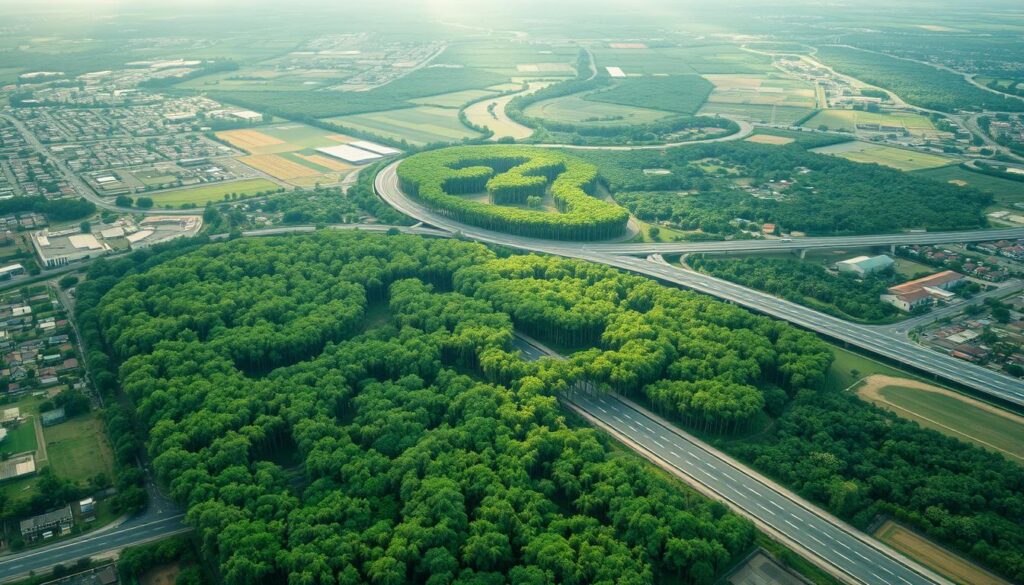China has made great strides in protecting giant pandas, with 67 panda reserves now in place. These reserves protect almost two-thirds of the wild pandas and half of their habitat. Yet, habitat loss and fragmentation pose the biggest threats to their survival.
A significant portion of the panda’s habitat has been lost. It was cleared for timber, fuel wood, agriculture, and infrastructure. This is due to the growing population in the area Panda Population Recovery.
In 1998, China banned logging in panda habitats. However, new roads and railways are still cutting through these areas. This isolates panda populations and makes them vulnerable to bamboo die-offs. Bamboo is crucial for pandas, making up 99% of their diet.
Key Takeaways
- The giant panda population is currently around 1,860 individuals, making them a vulnerable species.
- Pandas face habitat loss and fragmentation, along with the impacts of climate change, as major challenges to their survival.
- Wild pandas are now confined to just six isolated mountain ranges in China, specifically in Gansu, Shaanxi, and Sichuan Provinces.
- Panda habitat is crucial for maintaining the health of their mountain forests and supporting biodiversity.
- Ongoing conservation efforts have helped increase the panda population, but threats like habitat loss and fragmentation remain significant challenges.
Introduction: The Giant Panda’s Recovery
The giant panda was once on the edge of extinction. But thanks to hard work in conservation, their numbers are slowly rising. This gives us hope for their future.
Significance of Giant Panda Conservation
The giant panda is more than just a symbol of wildlife. It’s a key part of its ecosystem. As a keystone species, its health affects the whole area. Saving the panda means protecting the entire ecosystem.
Recent Progress and Challenges
Today, there are about 1,864 giant pandas in the wild. Another 600 live in zoos and breeding centers. This is a big improvement from when their numbers were very low.
But, there are still big challenges. Losing their habitat is a major threat. Deforestation and human activities keep shrinking their space. Keeping pandas’ populations healthy and connected is key to their survival.
| Key Panda Population Statistics | Numbers |
|---|---|
| Giant pandas in native habitat | 1,864 |
| Giant pandas in zoos and breeding centers | 600 |
| Percentage of genetic diversity preserved in human care | 90% |
| Giant panda nature reserves in China | 67 |
“The gift allowed the Zoo’s animal care and the Smithsonian Conservation Biology Institute’s scientific team to proceed with a five-year science plan with Chinese colleagues focusing on research and conservation initiatives.”
Habitat Loss and Fragmentation

The giant panda’s fight for survival is tied to saving its home. Sadly, much of the panda’s habitat has been lost. Logging and land changes for farming and roads have harmed their forests.
Even with a logging ban since 1998, new roads and railways still harm forests. This makes it hard for pandas to find food and mates. Without new bamboo, pandas face a big problem.
Deforestation and Land-Use Changes
Deforestation and land changes have hurt the panda’s home. More people in the panda’s area have led to forest loss. Now, only about 46% of the panda’s home is safe.
Isolation of Panda Populations
Human projects like roads and railways have split panda groups. This makes it hard for pandas to find mates and food. Isolated pandas are also more at risk when bamboo dies off.
“The panda’s recovery has been geographically uneven, with evidence of improving connectivity and gene flow resulting from conservation efforts.”
Panda Population Recovery: Successes and Setbacks

Protecting the giant panda has seen big steps forward. The Chinese government has set up 67 panda reserves. These areas protect over two-thirds of the wild pandas. They also work with the World Wide Fund for Nature (WWF) to create bamboo corridors. These corridors help pandas move, find food, and breed better.
But, there are still big challenges. A study from 1999 to 2003 and 2011 to 2014 showed some bad news. Livestock and human activities are increasing in panda habitats. This might push pandas to move to higher places.
Yet, there’s still hope. The study found pandas in recovering habitat more than expected. This shows that protection efforts are working. Logging in panda habitat has also decreased, giving pandas a better chance.
“Pandas are observed to be using younger secondary forests more than before, indicating that protection measures have allowed these forests to recover and become more suitable for pandas.”
As the panda population recovery keeps going, we need to keep working. Scientists from China West Normal University, Sichuan Forestry Bureau, the Chinese Academy of Sciences, and San Diego Zoo Global have shared important findings. These insights will help shape future conservation plans.
The fight to save the giant panda is ongoing. But, the successes and challenges show how crucial conservation efforts are. We must keep fighting to ensure this iconic species thrives for years to come.
The Role of Conservation Efforts

The giant panda’s recovery is thanks to the Chinese government and global groups like the World Wide Fund for Nature (WWF). They’ve created bamboo corridors. These paths connect panda habitats, letting pandas roam, find food, and meet mates.
In 1998, China banned logging in panda areas. This helped keep their forests safe. But, new roads and railways still threaten their homes. Protecting their habitats and fighting deforestation are key to their survival.
Bamboo Corridor Development
The Chinese government and WWF have made bamboo corridors. These paths help pandas move between forests. They find more food and mates, helping the panda population grow.
Habitat Restoration and Protection Measures
- The Chinese government banned logging in panda habitats, a big step in saving their forests.
- They’re working to fix damaged panda habitats through reforestation and fighting land-use changes.
- The Giant Panda National Park, covering over 2.6 million hectares, is a protected home for pandas.
- Training programs have taught over 1,500 Chinese wildlife experts how to protect pandas and their homes.
These efforts by the Chinese government and its partners have helped pandas thrive. By focusing on bamboo corridors and habitat protection, the panda’s future looks good.
| Conservation Measure | Outcomes and Impacts |
|---|---|
| Logging ban in panda habitats | Preservation of critical forest ecosystems |
| Bamboo corridor development | Increased connectivity and mobility for pandas |
| Habitat restoration and reforestation | Expansion of suitable panda habitats |
| Establishment of Giant Panda National Park | Dedicated, protected area for panda conservation |
| Conservation training programs | Capacity building for wildlife professionals |
Panda Population Recovery: Insights from Large-Scale Studies

Recent research has given us new insights into the giant panda’s recovery. A study by China’s State Forestry Administration in Sichuan Province covered three-quarters of the panda’s range. It showed how pandas use their habitats and how their numbers are changing.
The study took nearly 70,000 person-hours to complete. It found that pandas are now using younger forests more. This is because of conservation efforts that have helped these forests grow back.
But, the study also found some bad news. More livestock and human activities are entering panda habitats. This could make pandas move to higher places, which is a big challenge for their survival.
Despite these threats, the outlook is still good. The International Union for Conservation of Nature (IUCN) has moved the giant panda from “Endangered” to “Vulnerable.” Large-scale studies like this help us understand how to keep pandas safe. They guide conservation science and recovery programs for the panda population’s future.
“These benchmark studies are crucial for understanding how pandas are responding to the changing landscape and the effectiveness of our conservation efforts,” said a researcher from the China West Normal University. “The insights gained will inform our data collection and recovery programs to ensure the panda population continues to thrive.”
Working together, places like the San Diego Zoo Global and the State Forestry Administration have made these studies possible. As the giant panda moves from endangered to vulnerable, we must stay alert and keep managing their habitats well. This will help their recovery continue.
Future Strategies for Panda Conservation

As the giant panda population grows, we must change how we protect them. We need to expand and connect protected areas. Also, we must reduce conflicts between humans and pandas.
Expanding and Connecting Protected Areas
The Chinese government has grown the number of panda reserves to 67. Yet, about one-third of pandas live outside these areas. We must keep growing these areas and connect them with wildlife corridors.
This will let pandas roam and find new food sources. Expanding reserves and linking them helps pandas live in bigger, more varied habitats. It also reduces the dangers from human development, logging, roads, and railways.
Mitigating Human-Wildlife Conflicts
As pandas recover, conflicts with humans may rise. We need to find ways to lessen disturbance and land-use changes in their homes. This includes making plans for habitat recovery and adaptive management.
These plans will help reduce the effects of livestock and other human activities on pandas. By tackling these issues, we can ensure pandas have a secure future.
Also Read : Exploring China’s Panda Reserves: Best Eco-Tourism Packages for 2024
Conclusion: Ensuring Long-Term Survival of the Giant Panda
The giant panda population in China has seen a positive trend. From 2001 to 2013, the number of wild pandas increased by 16.8%. This is a hopeful sign, but the species still faces big challenges. Habitat loss and fragmentation from human activities are major threats.
Even though the panda’s status has been downgraded from “Endangered” to “Vulnerable,” it’s not out of danger yet. Experts say the panda should still be considered “Endangered.” This is because of ongoing habitat issues, low population connections, and weak protection plans. The decline in biodiversity is expected to worsen, making urgent action necessary.
To ensure the giant panda’s future, we need to expand and connect protected areas. We must also restore and protect their habitat and reduce human-wildlife conflicts. By doing these things, we can build on past successes and keep the panda’s status improving. With careful planning and action, the giant panda can continue to symbolize conservation success and our ability to protect biodiversity.
FAQs
Q: What are the biggest challenges to maintaining the giant panda population recovery?
A: The biggest challenges include habitat loss due to agriculture and urbanization, which affects the suitable habitat landscape for pandas. Additionally, the small population and fragmented habitats increase the risk of local extinction.
Q: How does habitat quality impact the giant panda population?
A: Habitat quality is crucial for the survival of the giant panda population. High-quality bamboo forests are essential for their diet, and any degradation in habitat can significantly impact their numbers and lead to endangerment.
Q: Are pandas still at risk despite conservation success?
A: Yes, despite being removed from the IUCN Red List of endangered species, giant pandas are still at risk. They face threats from habitat fragmentation and climate change, which can affect the availability of suitable habitat.
Q: What role do local communities play in panda conservation?
A: Local communities play a vital role in panda conservation by engaging in sustainable practices that protect giant panda habitats. Their cooperation can enhance the ecological balance and contribute to the increasing population size of pandas in China.
Q: How does the integrated network of giant panda reserves help in species recovery?
A: The integrated network of giant panda reserves helps in species recovery by connecting fragmented habitats, allowing pandas to move between areas, which promotes genetic diversity and population dynamics necessary for a healthy giant panda population.
Q: What are the effects of climate change on giant panda habitat?
A: Climate change poses a threat to giant panda habitat by altering the bamboo forest ecosystems. Changes in temperature and precipitation can reduce bamboo growth, which is essential for the giant panda’s diet and overall survival.
Q: How can captive-bred giant pandas contribute to wild populations?
A: Captive-bred giant pandas can contribute to wild populations through carefully managed reintroduction programs. These programs aim to ensure that pandas moved permanently to a new habitat area are well-adapted to living in the wild.
Q: What are some conservation efforts being made to protect giant pandas?
A: Conservation efforts include the establishment of giant panda reserves, habitat restoration projects, and ongoing research by organizations like WWF, which has been working to ensure the long-term survival of this conservation icon.
Q: Why is the giant panda considered a conservation icon?
A: The giant panda is considered a conservation icon because it represents the broader movement for wildlife conservation. Its recovery efforts have inspired global attention towards protecting endangered species and their habitats.

